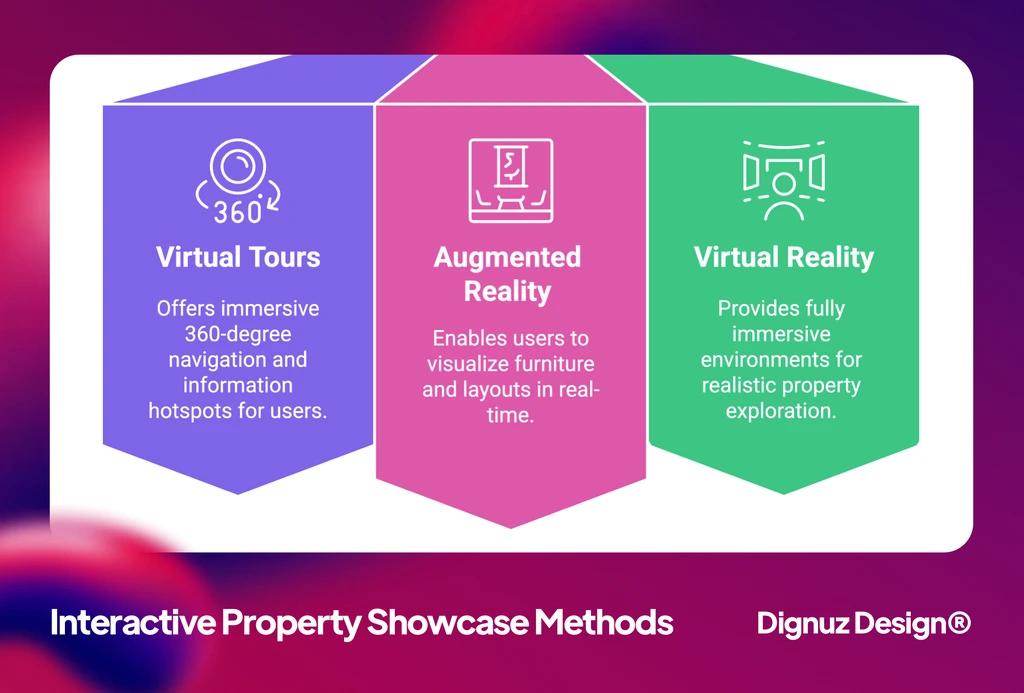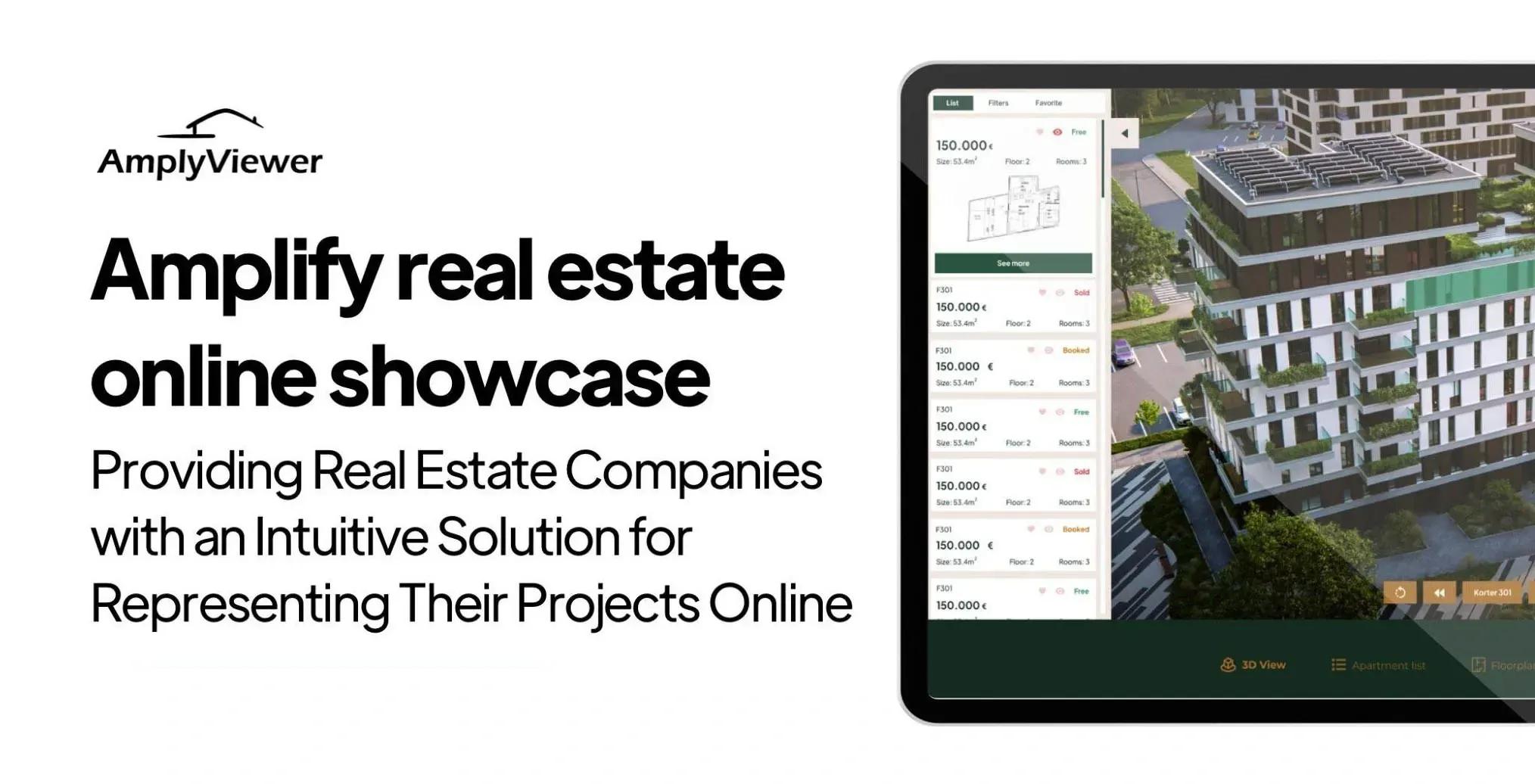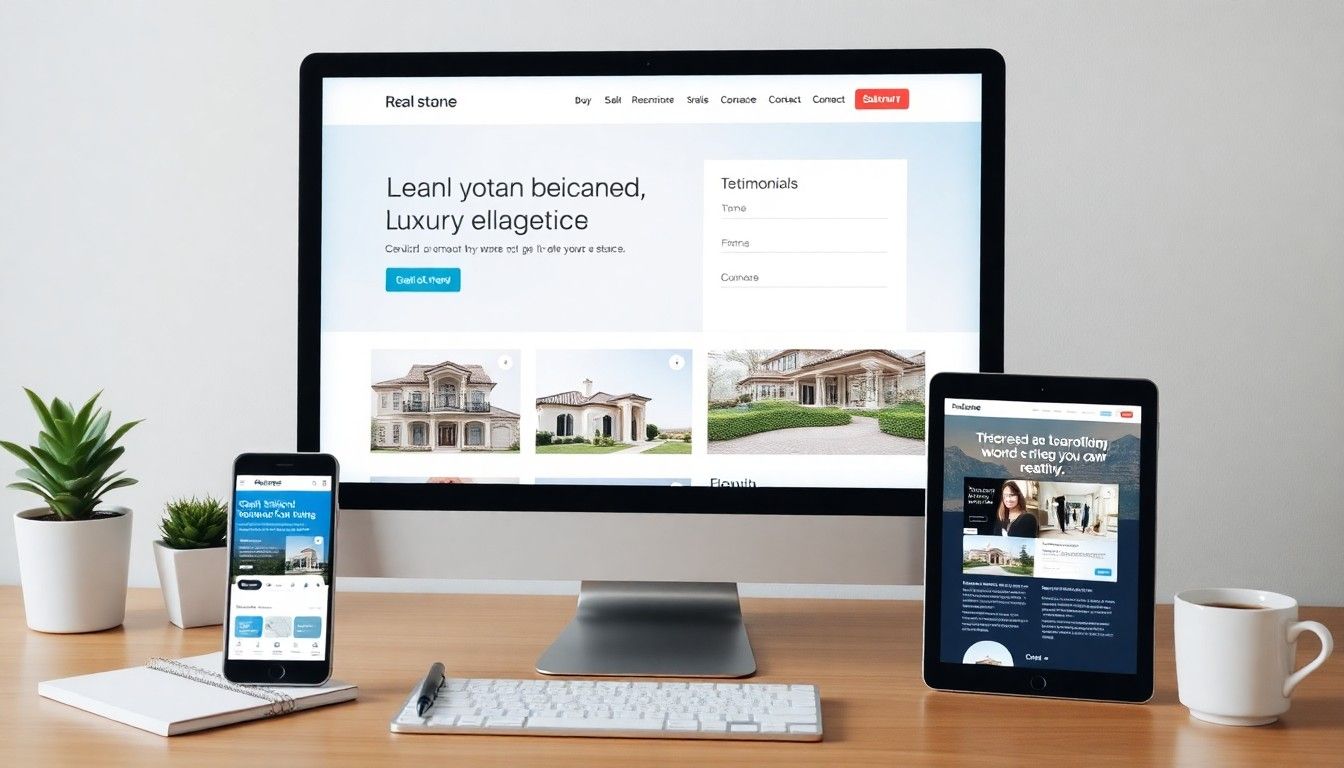Real Estate Design: Interactive Ways to Showcase Properties

Property visualization technology has transformed how real estate professionals present listings to potential buyers. Virtual house tours now capture 87% more views than traditional listings, revolutionizing the way properties are showcased online (Source: AgentUp). For real estate professionals seeking to stay competitive, implementing interactive showcase methods isn't just an option—it's essential for success.
The challenge? Many real estate businesses struggle to effectively implement these digital visualization tools, often missing out on valuable opportunities to engage potential buyers. The solution lies in understanding and leveraging the right mix of interactive showcase methods that align with buyer expectations in 2025.
Advanced real estate 3D visualization techniques have opened up new possibilities for property presentation, making it easier than ever to create immersive experiences that convert viewers into serious buyers. Here's your comprehensive guide to the seven most effective interactive property showcase methods for 2025.
The Evolution of Virtual Property Tours
Virtual property tours have become a non-negotiable element in modern real estate marketing. With 54% of home buyers refusing to schedule showings without first viewing a virtual tour, this technology has shifted from a luxury add-on to a fundamental marketing requirement (Source: AgentUp). Understanding current real estate marketing trends reveals why these interactive experiences are reshaping property showcases.
360-Degree Interactive Experiences
Modern 360-degree virtual tours offer unprecedented control and detail in property exploration. These immersive experiences allow potential buyers to:
- Navigate through spaces at their own pace
- Zoom in on specific architectural details
- Access embedded information about features and finishes
- View properties at any time, from any location
The technology behind these tours has evolved significantly, incorporating high-resolution imagery and smooth navigation controls that create a seamless viewing experience. Property details are presented through interactive hotspots, offering instant access to information about materials, dimensions, and smart home features.

Impact on Buyer Engagement
Virtual tours transform passive property listings into interactive experiences that capture and maintain buyer interest. The technology enables real estate professionals to showcase properties in their best light, highlighting key features while providing a genuine sense of space and flow. This level of transparency builds trust with potential buyers, streamlining the decision-making process.
Integration with property listings has become more sophisticated, allowing for seamless embedding of virtual tours within real estate websites and marketing materials. This integration creates a cohesive digital presence that enhances the overall property presentation while providing valuable insights into buyer behavior and preferences.
Augmented Reality in Property Visualization
Augmented Reality (AR) has revolutionized property visualization by enabling potential buyers to personalize and interact with spaces in real-time. This technology proves particularly cost-effective, as virtual staging through AR costs 97% less than traditional home staging methods (Source: AgentUp). The integration of real estate 3D model creation with AR applications opens up unprecedented possibilities for property customization.
Real-Time Space Customization
AR applications provide powerful visualization capabilities that transform empty spaces into personalized environments. These tools offer several key advantages:
Virtual Furniture Placement
- Buyer Benefit: Visualize personal belongings in space
- Agent Advantage: Show property potential without physical staging
Color Scheme Testing
- Buyer Benefit: Preview different wall colors and finishes
- Agent Advantage: Demonstrate renovation possibilities
Layout Optimization
- Buyer Benefit: Experiment with different furniture arrangements
- Agent Advantage: Highlight space versatility
Renovation Preview Features
AR technology excels in helping buyers visualize potential renovations and modifications. Through sophisticated rendering capabilities, users can:
- Preview different flooring options in real-time
- Visualize removed or added walls
- Test different lighting configurations
- Explore kitchen and bathroom upgrade options
The technology's ability to blend digital elements with physical spaces creates a powerful tool for decision-making. Buyers can make more confident choices about properties by seeing their vision come to life through AR overlays, while agents can effectively demonstrate a property's potential without physical modifications.
Implementation of AR features requires careful attention to detail and accurate 3D modeling to ensure realistic visualization. When properly executed, these tools significantly reduce the time and resources needed for property staging while providing a more flexible and interactive experience for potential buyers.
Virtual Reality Home Tours: Beyond Basic Visualization
Virtual Reality (VR) technology has transformed property showcasing by creating truly immersive experiences. Data shows that buyers are 95% more likely to inquire about properties offering virtual tours (Source: AgentUp). Through platforms like AmplyViewer, real estate professionals can now offer photorealistic virtual property experiences that rival in-person visits.
Immersive Property Experiences
VR technology delivers several distinct advantages for property showcasing:
- Complete Spatial UnderstandingUsers experience true-to-scale environments, gaining accurate impressions of room dimensions, ceiling heights, and spatial relationships between areas.
- Time-of-Day VisualizationBuyers can observe how natural light affects different spaces throughout the day, understanding the property's lighting dynamics.
- Multiple Layout ScenariosVR enables viewing different furniture arrangements and renovation options within the same space, helping buyers envision possibilities.
International Buyer Benefits
VR tours particularly benefit international and long-distance buyers by providing:
- Detailed property exploration without travel
- Real-time virtual walkthroughs with agents
- Interactive measurement tools
- Multi-language support for property information
Hardware Compatibility and Implementation
Modern VR property tours accommodate various viewing options:
VR Headsets
- User Experience: Full immersion with 360° movement
- Best For: Detailed property evaluation
Mobile Devices
- User Experience: Gyroscope-controlled viewing
- Best For: Quick property overview
Desktop Browsers
- User Experience: Mouse-controlled navigation
- Best For: Initial property screening
The versatility of VR technology ensures that property showcases remain accessible while offering increasingly sophisticated visualization options. This multi-platform approach helps real estate professionals reach wider audiences while maintaining high-quality presentation standards across all viewing methods.

Interactive Hotspots and Smart Property Details
Interactive hotspots transform static property listings into engaging, information-rich experiences. Properties utilizing these features receive 87% more views, with buyers spending 5-10 times longer exploring the listings (Source: CBRE). Understanding how to implement these features effectively is crucial, as outlined in our estate agent website guide.
Enhanced Property Information Delivery
Smart property details leverage interactive hotspots to create intuitive information layers:
Feature Highlights
- Information Displayed: Material specifications, brand names, warranty details
- User Value: Detailed product information without visual clutter
Room Statistics
- Information Displayed: Dimensions, window orientation, storage capacity
- User Value: Quick access to essential measurements
Smart Integration
- Information Displayed: Connected devices, automation features, energy systems
- User Value: Understanding of property's tech capabilities
Smart Home Integration Showcases
Interactive hotspots excel at demonstrating smart home capabilities through:
- Virtual demonstrations of automated systems
- Energy efficiency feature highlights
- Security system overviews
- Connected appliance specifications
Dynamic Information Architecture
The implementation of interactive hotspots follows a strategic information hierarchy:
- Primary Information LayerEssential details like room dimensions and basic features appear immediately when accessing a space.
- Secondary Information LayerDetailed specifications and technical information become available through user interaction.
- Tertiary Information LayerIn-depth documentation, warranty information, and maintenance schedules are accessible through dedicated menus.
This layered approach to information presentation prevents overwhelming viewers while ensuring all relevant details remain easily accessible. The system adapts to user behavior, prioritizing frequently accessed information and streamlining the property exploration process.
AI-Powered Personalization in Property Tours
Artificial Intelligence has revolutionized how buyers interact with property listings through sophisticated personalization. Modern AI systems enhance the user experience by providing customized home finishes and guided tours based on individual preferences (Source: Chameleon Interactive). Integrating these capabilities with real estate marketing automation creates a more engaging and relevant property showcase experience.
Machine Learning Applications
AI-powered property tours utilize machine learning in several key ways:
Behavioral Analysis
- Functionality: Tracks viewing patterns and preferences
- Buyer Benefit: More relevant property recommendations
Smart Highlighting
- Functionality: Emphasizes features based on user interest
- Buyer Benefit: Personalized property exploration
Predictive Navigation
- Functionality: Suggests optimal viewing sequences
- Buyer Benefit: Enhanced property discovery experience
Preference-Based Recommendations
The AI system learns and adapts through:
- Analysis of viewing duration for different features
- Recognition of repeated area visits
- Tracking of specific feature interactions
- Processing of user-provided preferences
Virtual Space Customization
AI-driven customization enables real-time property modifications:
- Dynamic Style AdaptationThe system automatically adjusts interior design elements based on user preferences and previous interactions.
- Smart Feature HighlightingAI identifies and emphasizes property features that align with specific buyer interests and requirements.
- Automated Tour GenerationCustom virtual tours are created based on individual preferences and viewing patterns.
The integration of AI technology creates a more intuitive and responsive property viewing experience. By analyzing user behavior and preferences in real-time, these systems can adjust property presentations to match individual buyer interests, significantly improving engagement and conversion rates.
This personalized approach helps buyers focus on relevant features while streamlining the property evaluation process. The system continuously learns from user interactions, making each subsequent viewing more targeted and effective.

💻 Let us help you create a stunning online showcase for your projects that works seamlessly across all devices. Ready to amplify your real estate business? 👉 Explore AmplyViewer now
Social Media Integration and Short-Form Content
Social media platforms have become crucial channels for property showcasing, particularly for reaching younger buyers. Research shows that Gen Z buyers are 130% more likely to schedule viewings when properties feature virtual content (Source: AgentUp). Effective real estate marketing on YouTube and other social platforms requires a strategic approach to content creation and distribution.
Platform-Specific Strategies
Each social media platform requires unique content optimization:
- Optimal Content Type: Reels and Stories
- Key Features: Quick property highlights, behind-the-scenes tours
TikTok
- Optimal Content Type: Short-form videos
- Key Features: Creative property reveals, feature spotlights
YouTube
- Optimal Content Type: Long-form tours
- Key Features: Detailed walkthroughs, area guides
Video Content Optimization
Effective property videos should include:
- Engaging opening sequences that capture attention
- Clear property highlights within the first 15 seconds
- Professional lighting and stabilized camera work
- Consistent branding elements
- Clear calls-to-action
Cross-Platform Integration
Create a cohesive social media presence through:
- Content AdaptationModify property showcase content to suit each platform's specifications while maintaining consistent messaging.
- Interactive ElementsIncorporate polls, questions, and interactive stickers to boost engagement and gather viewer feedback.
- Strategic TimingSchedule posts during peak engagement hours for maximum visibility and interaction.
Engagement Metrics and Analytics
Track social media performance through key metrics:
- View duration and completion rates
- Engagement rates (likes, comments, shares)
- Click-through rates to property listings
- Lead generation from social platforms
Success in social media property showcasing requires a balance between entertainment and information. Content should be engaging enough to stop viewers from scrolling while providing valuable property insights that motivate serious inquiries.
Predictive Analytics in Property Showcases
Predictive analytics has transformed property showcasing by combining digital twins with event-focused strategies, effectively bridging geographical gaps and accelerating sales cycles (Source: Chameleon Interactive). This technology integration has become crucial for successful real estate development marketing, enabling data-driven decision-making in property presentations.
Market Trend Analysis
Predictive analytics enhances property showcasing through:
Buyer Behavior Patterns
- Application: Identifies optimal showcase timing
- Marketing Benefit: Improved viewing scheduling
Feature Preference Tracking
- Application: Highlights most-valued amenities
- Marketing Benefit: Targeted property highlighting
Market Demand Forecasting
- Application: Predicts property interest levels
- Marketing Benefit: Strategic marketing timing
Smart Listing Optimization
Predictive tools enhance property listings through:
- Dynamic content prioritization based on viewer preferences
- Automated highlight reel generation
- Personalized feature recommendations
- Real-time pricing optimization
Data-Driven Property Presentation
Implementation follows a structured approach:
- Data CollectionGather viewer interaction data, preference patterns, and engagement metrics across all showcase platforms.
- Analysis and Pattern RecognitionProcess collected data to identify trends and optimize property presentation strategies.
- Automated OptimizationImplement real-time adjustments to property showcases based on analytical insights.
Future-Forward Applications
Advanced predictive analytics enable:
- Virtual open house optimization based on attendance patterns
- Automated follow-up timing recommendations
- Predictive maintenance scheduling for property features
- Market value trajectory forecasting
The integration of predictive analytics with property showcasing creates a more efficient and effective marketing process. By leveraging data-driven insights, real estate professionals can better anticipate buyer needs and optimize their presentation strategies for maximum impact.
Implementation Guide for Real Estate Professionals
Implementing interactive property showcase methods requires strategic planning and the right tools. The investment pays off significantly, as virtually staged listings sell 75% faster, with 83% selling at or above asking price (Source: AgentUp). Before diving into implementation, review our AmplyViewer pricing options to find the solution that best fits your needs.
Technology Selection Criteria
Choose the right showcase technologies based on these key factors:
Virtual Tours
- Essential Elements: 360° coverage, hotspot capability, mobile optimization
- Implementation Priority: High - Primary Tool
AR/VR Features
- Essential Elements: Device compatibility, rendering quality, user interface
- Implementation Priority: Medium - Secondary Phase
Analytics Integration
- Essential Elements: Data tracking, reporting features, integration capabilities
- Implementation Priority: High - Essential Component
Implementation Steps
- Assessment and PlanningEvaluate your current showcase methods and identify gaps in your presentation strategy.
- Technology IntegrationBegin with core virtual tour functionality, then gradually add AR/VR capabilities.
- Team TrainingEnsure all team members understand how to utilize and demonstrate new showcase features.
- Content CreationDevelop high-quality visual content optimized for each platform and technology.
Cost Considerations
Budget effectively by prioritizing investments:
- Essential hardware and software licenses
- Content creation and optimization tools
- Staff training and development
- Ongoing maintenance and updates
ROI Analysis Framework
Track return on investment through these key metrics:
Time to Sale
- Measurement Method: Days on market comparison
- Success Indicator: 25% or greater reduction
Viewer Engagement
- Measurement Method: Time spent on listings
- Success Indicator: 3x increase in viewing duration
Lead Quality
- Measurement Method: Showing request conversion rate
- Success Indicator: 40% or higher conversion
Success in implementing interactive showcase methods requires a balanced approach between innovation and practicality. Start with core features that deliver immediate value, then expand your capabilities based on performance data and user feedback. Regular assessment of metrics ensures your showcase strategy remains effective and competitive.
Frequently Asked Questions About Interactive Property Showcasing
Understanding interactive property showcasing methods is crucial for success in today's real estate market. With 75% of sellers seeing a 5-15% increase over asking price when using virtual staging (Source: Chameleon Interactive), these technologies offer significant returns. For personalized guidance on implementing these solutions, contact Dignuz Design for a consultation.
Common Questions About Interactive Property Showcasing
What is the initial investment needed for interactive property showcasing?
Initial investments vary based on your chosen technologies:
- Basic virtual tour setup: $500-1,500
- AR/VR implementation: $2,000-5,000
- Complete interactive showcase system: $5,000-10,000
- Monthly maintenance and hosting: $100-500
How long does it take to implement these technologies?
Implementation timelines typically follow this schedule:
- Virtual tour setup: 1-2 weeks
- AR feature integration: 2-4 weeks
- VR experience development: 3-6 weeks
- Full system implementation: 6-8 weeks
What technical expertise is required to manage these systems?
Modern interactive showcase platforms are designed for user-friendly operation. Most systems require:
- Basic digital photography skills
- Fundamental computer operation knowledge
- Basic understanding of virtual tour software
- Familiarity with mobile devices and apps
How can I measure the success of interactive showcasing?
Success can be measured through several key metrics:
- Viewing time per property
- Number of virtual tour completions
- Lead generation rates
- Time to sale comparison
What are the most common challenges in implementation?
Common challenges include:
- Initial learning curve for new technologies
- Content creation and optimization
- System integration with existing platforms
- Maintaining consistent quality across all features
Next Steps
Ready to enhance your property showcasing strategy? Here's how to get started:
- AssessmentEvaluate your current showcase methods and identify areas for improvement.
- PlanningDevelop a implementation strategy aligned with your business goals and budget.
- ImplementationBegin with core features and gradually expand your interactive showcase capabilities.
- OptimizationContinuously monitor performance and adjust your approach based on results.
Transform your property showcasing approach with professional guidance. Our team specializes in implementing cutting-edge interactive solutions that drive results. Contact us today to discuss your specific needs and goals.


